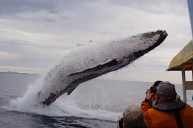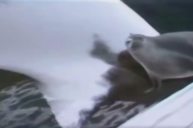A 2-year-old humpback whale was spotted in Boston Harbor on Tuesday. While whale watchers were rejoicing this past Tuesday, naturalist manager Linnea Mayfield was not. Although people on whale-watching tours hope to see whales, it is not always a good thing. Apparently, seeing a whale that far up into the harbor is not very common.
Whales In Distress?

Paul Wolf, Getty Images
Although it was exciting to witness this young humpback whale in Boston Harbor, it is also a potential sign of concern. First and foremost, it concerns the whale's safety. There are many boats in Boston Harbor, which means the chances of the whale being struck by a vessel greatly increase. Furthermore, this situation can lead to heightened stress for the whale.
Linnea told local news that the whale most likely ended up there because it was chasing prey or in distress. As soon as the whale-watching tours noticed the humpback whale, they gave it space. They later reported it to the National Oceanic and Atmospheric Administration.
She then goes on to explain, " If we find a whale in an area where they don't normally occur, we might stop with them for a few minutes, take a brief look, ensure that the animal seems physically intact, is not entangled in fishing gear or anything like that, doesn't seem to have any visible, notable injuries, and then we'll move on."
Human Impact On Humpback Whales

Shutter stock
Although whales are much larger than humans, our impact on them is much larger than theirs on us. According to the International Whaling Commission (IWC), "Humpback whales may be at risk from a number of threats, including entanglement in fishing gear, ship strikes, habitat degradation, oil and gas development, and climate change."
With all of these threats to whales, it is no wonder that they may be in distress. So remember, even if you are on a whale-watching expedition, always give these gentle giants their space. While we love to see these stunning creatures, it is best to see them from afar so we do not meddle with their natural habitat.




